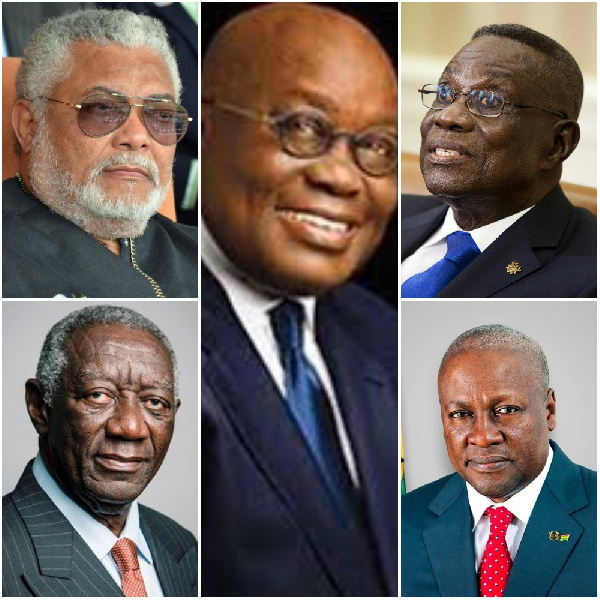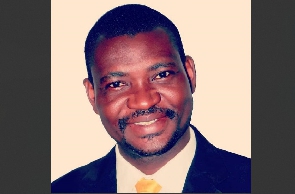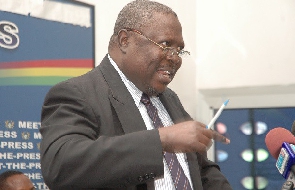It is an established fact that those who normally fail to prepare for change when it is coming, go down in history when it arrives.
The Chain in the Eight Year Cycle is a creature of the 1992 constitution and remains an enigma whose disconnect is yet to be manifested in the history of the Fourth Republic of Ghana.
The manifestation since 1992 is how both major political parties need always to break the chain in the eight so that they can retain power, come to power, or remain in opposition.
It is not out of nothing that the late former President Jerry John Rawlings still remains very fresh in our minds as if he just travelled outside the country.
His very ardent political opponents throughout his political history to date have found favour in his wisdom that laid down the very structure and foundation of the 1992 constitution.
Beneath this constitution lies the secret of unquestionable power to the effect that Politicians from both major parties enjoy it when in power and oppose it when in opposition.
This secret of implicit power embedded in the 1992 Constitution is like a double-edge dagger.
This dagger defends the wielder from the bickering and inequity of his own people, whom he intends to defend, while attacking the assailant at the same time.
This burden that the 1992 Constitution places on subsequent leaders or Presidents of the Fourth Republic was fashioned out to fit the hands of the first President of the Fourth Republic.
Thus, to enable him to meet the security demands of the time and the incidents surrounding his intentions to originally introduce the 1992 constitution.
It was this constitution which enabled him to change from dictatorship to democracy.
This first President of the fourth republic, late Jerry John Rawlings used the same system of laws to prevent continuity of his own dictatorship and go ahead to lay down the foundation for democratic rule in Ghana.
This way of arrangement reflects the lessons learnt from the June 4th Uprising, the flaws that led to the success of it, and the lessons of betrayal learnt from the first President of Ghana, Dr. Kwame Nkrumah following his 1966 overthrow.
Hence the first essence of the 1992 Constitution, as was introduced, is to form a shield of the presidency against friends and enemies alike.
And secondly to introduce democracy to the people no matter how relative its effects were to last and in direct comparison to Ghana under the AFRC and PNDC military regimes of Jerry Rawlings.
The experiences under the AFRC, PNDC and the calls for Change all together under former President Rawlings metamorphosed into the democratic political party known as the National Democratic Congress (NDC).
Despite a large opposition calling for Rawlings to step down, the NDC became the first Political party and government of the fourth Republican (1992) Constitution.
The eight years idea of our democratic experience of change in governance happening between two major political parties is as a result of the system of laws that regulates the entire electoral or democratic process.
Examples include the election year Constitutional Instrument (CI) and the Rules of Court formulated to determine the aftermath events of electoral disputes.
The opposition of the dictatorship of President Rawlings at the time, equally led to the emergence of a very large political group, the New Patriotic Party (NPP).
The NPP contested in the 1992 and 1996 elections and lost to the Rawlings NDC.
This turn of things, led to the whole of Ghana divided under these two major political parties.
And since 1992, our electoral system, underpinned by the same laws and same major political actors, has inherited this secretly embedded double-edge dagger.
The political actors use this dagger to their advantage as it secretly awards absolute authority to any political party in power and manifests democracy in name only, right from its foundation.
Furthermore, this absolute authority has implanted in the heart of the nation some kind of political rivalry because of the absolute power clauses of the executive arm of government.
This absolute power appears to be more intense than normal politics as its adverse effects tend to impact negatively on our economic growth.
The general indication that is predicting more political intricacies in the future is that as the 1992 Constitution was made to convert autocracy into democracy, it does equally have the power to turn a democratically elected leader into an autocratic one based on interpretation and application of the same laws.
The power of the President to decide under the 1992 Constitution is unchecked and unmatched such that all the three arms of government are ultimately tilted to the advantage of the president.
The president has the oversight responsibility and final decision making power over all the three arms of government.
As an implicit and ultimate power holder of the legislature, the president must assent to bills before they become laws.
As an indirect and ultimate power holder over the judiciary, the President has the one power of presidential pardon that only he (she) can exercise.
According to article 54(7) of the Constitution, as the leader of the executive arm, the President is not directly accountable for his actions and or omissions.
This epitomises the reversal of the agency theory.
Where the origin of power becomes the subject of the power, the object of the power becomes absolute.
And as the saying goes, “absolute power corrupts absolutely”.
Otherwise, both article 1(1) and 257(6) of the 1992 Constitution consider the power of the President as trust.
And by article 58(5) all executive appointees act in the name of the President.
Where a trustee becomes an absolute owner of the object of trust, that would surely amount to an absolutely corrupt power.
The first sign of this power corruption is lack of accountability in the use of power and the actions and decisions of the person to whom power has been entrusted.
Under article 2 (1)(b) of the Constitution, an act or omission of the President in that case and as the law stipulates, is subject to judicial interpretation or a declaration but not to any legal understanding with regards to what kind of act or omission.
Under what bases would the supreme court determine that an act or omission of the President amounts to a violation?
To say the president acted unconstitutionally is not enough, if this unconstitutional behaviour stands to cost the fortunes and future of the nation.
So by article 57(4), the courts implicitly have no capacity to hold the President accountable as consolidated under article 57(5) of the Constitution.
In this, the command theory of law John Austin was taken into consideration in the spirit of but contrary to the letter of the 1992 Constitution.
This theory suggests that there must be one supreme authority who orders everyone in the society and whom we must follow or else be subjected to sanctions.
Well, it is clear that every authority under this constitution holds power in the name of the President, and cannot act contrary to his orders.
So under the 1992 Constitution, the President is not bigger than the law, but neither is the law bigger than the president.
This is indicated by the conflict of article 2(1) b and article 57(5).
The conflict is that while the former brings the President under accountability, the latter exonerates him from blame.
This double-edge dagger nature of the law has given ample freedom for leaders to make wild mistakes that have impacted negatively on our economic progress since 1992 as it provides democracy only in name and prevents strict accountability.
While the late former President Rawlings was insisting on probity and accountability in his last days, he knew that by the very nature of our Constitution governmental forces cannot really be held accountable.
Even the supreme court has no ample room to hold the President ultimately accountable.
This post mortem nature of our presidential laws has been the silent window for the perpetuity of unquestionable dictatorship since 1992.
Therefore, by this nature of our laws regulating our democratic decisions, we the people are effective in checking governmental forces in name only.
This has opened more room for less accountability especially at times when it really matters most.
Thus breaking the Chain in the Eight is much easier contrary to what the masses may be thinking.
Simply put, the mandate of the supreme court in matters relating to the President and in the conduct of electoral issues has no actual legally accountable basis.
The constitution as a parent law authorises, but the procedural aspect of the issue authorised must be contained in another law.
The supreme court has no law to rely on and impeaching the president on grounds of an act is very hard since the authority conferred on the President by the 1992 Constitution is uncodified.
To prevent the further killing of judges as known in the history of our politics, an implicit master-servant relation would suffice as captured in the spirit of the 1992 Constitution.
The cumbersome, if not impossible, nature of the process of impeachment as laid down in article 69 of the Constitution is a justification of the intent to consolidate the power already conferred on the President.
During elections, the Rules of Court set out by the judiciary under article 64(3) and the constitutional instrument issued to regulate the election of the President under article 63 (2) of the 1992 Constitution all come under the influence of the President as powerful as he is.
The appointment of the Chief Justice by the President under article 144, to some extent, and in a wild political environment of rivalry does not only impede the needed justice; it also creates the lack of confidence for justice to be carried out.
So you may hear that the President is acting unconstitutionally but nowhere can you hear that the President has acted ultra vires.
Every other executive member of government can act ultra vires except the President.
So the courts in reality have no power to review the actions of the President.
According to article 125 of the Constitution, the judiciary is independent and free from the influence of the president.
This is so because it is only the President that has the capacity to influence the judiciary.

Jerry Rawlings, the founder of the 1992 Constitution had always wanted to have the judiciary under his control.
Until the inception of this constitution judges of the supreme court suffered under his hands in trying to enforce the rule of law.
Is there a need for change then?
This is the antecedent preceding the laws of the judiciary as captured in the 1992 Constitution.
In order of hierarchy of governmental forces as designed in the 1992 Constitution, the constitution is first, then follows the executive arm, judiciary, and legislature in that order.
Under article 11 of the Constitution, the Parliament is supposed to be the second ranking authority.
But the romance that the constitution has created between the executive and judiciary has indirectly conferred power on the executive arm of government above every other arm of government.
The main essence of this constitutional analysis is the ratio in the case of Martin Amidu v. Kuffour.
Nana Akufo-Addo, our current President was the attorney-general who raised the issue of original jurisdiction of the supreme court since there are other courts and where the jurisdiction of the judiciary is for declaration of the law.
Of course, and as expected, the supreme court claimed it had a mandate, and that no one was above the law.
But by the letter of the law as contained in the 1992 Constitution, the question of jurisdiction, and by the very structure of our system of laws, is relevant.
At the same time, the idea of nobody is above the law sounds like either a maxim of equity or a natural law jurisprudence whose effect is limited to alter the position of the constitution.
Equity surely follows the law but not the constitution.
Hence, the supreme court relying on the maxims of equity to resolve constitutional issues may not resolve the miscarriage of justice.
To say that the supreme court has no jurisdiction to hear someone’s case means the person is above the law.
But this is the unfortunate reality of the 1992 constitution.
The reversal of the Amidu v. Kuffuor case is the case of NPP V Attorney-General when Martin Amidu was the Attorney-General.
The success of this case is that the supreme court has jurisdiction, constitutionality, legality and power of court to place an injunction.
However, the key issue was that the actions of President Kufuor were not unconstitutional, but were subject to another law that was not inconsistent with the constitution.
So there always has to be a law and the President acting unconstitutionally is not enough to invoke the accountability question.
The general implication of the Constitution in relation to the President’s conduct is that he, the President, must have a specific law to contain his exceptions granted by the constitution.
Such a law should be separate from all laws binding on all citizens so that the President can fall foul within his own jurisdiction.
By the nature of our laws, the President’s actions have no jurisdiction, period!
Thus, under this nature of the 1992 Constitution, the two-party system has been established and the at least fifty percent rule for winning the Presidential election as stated in article 63(3) of the Constitution has divided the nation.
Worst of all, we currently have a hung parliament of fifty-fifty on both sides with the speaker being from the Minority side.
This nature of our parliament and our laws has made it possible that the chain in the eight can easily be broken.
What then is this Chain in the Eight?
The Chain in the Eight is within the eight year cycle of change in governance from one political party to the other, namely, change in power between NPP and NDC in every eight year cycle as manifested by the 1992 constitution.
This eight year cycle of change was started by late President Jerry John Rawlings as the first President of the Fourth Republic. His tenure ended in 2000.
From 2001 to 2008, former President J. A. Kuffour, the second President of the Fourth Republic, continued the eight year cycle of change.
He was succeeded by President J.E.A Mills as the third President of the Fourth Republic who also went through the Eight year Cycle.
But during this time, the chain in the eight year cycle of change was broken since the Vice President of the Fourth Republic, John D. Mahama had to take office by constitutional provision following the unfortunate demise of John E. A. Mills.
This created a fourth President of the Fourth Republic - John D. Mahama.
Thus, through this event, the chain in the eight year cycle has already been broken.
By splitting the eight year cycle to commence his own cycle, John D. Mahama broke the chain in the eight year cycle.
So this created an impasse on the force of the eight year cycle as JM had to secure his lead through triumph at the court following the 2012 presidential election.
President Akufo-Addo equally in the second term election in 2020 had to consolidate his victory at the court.
Now he has to work with a speaker of Parliament from the other side of the House.
So the force in the eight year cycle is on its deathbed.
This, therefore, means that the NPP can possibly break the eight contrary to the norm.
This is possible because it will reconnect with the twist in the path of the leadership cycle in the spirit of former President John D. Mahamah.
Therefore, and in conclusion, the fourth President of the Fourth Republic and the last of the John’s - John D. Mahama - by aspecting the third President, broke the chain of the John’s within the eight year cycle.
John Mahama converted the three (3) into a four (4), thereby opening the way for the new force with the fifth President under the Fourth Republic who never had the name John.
It is thus an enigma to indicate that at one period of time and in the same political party, there were two Johns at one time being both president and vice president; the president passed on for the vice president to continue an eight year cycle to completion.
The current President Akufo-Addo, is the new force of our political evolution.
With all this power conferred on him just like Rawlings, who always liked to be President and king maker, President Akufo-Addo is more likely to introduce a new political agenda whose parameters are totally different from the forces that conditioned the 8 year cycle of change under the 1992 Constitution.
Unlike Rawlings who loved both power and justice, the current President sees things differently.
He seems to know that power and justice are two opposing forces where the presence of one prevents the occurrence of the other.
Justice is another form of power and perhaps more difficult than power itself.
And in these matters, both the late President J.J. Rawlings and President Akufo-Addo understood/understand this idea of power and justice more than any other Presidents in this Fourth Republic.
This is why in the 2012 presidential election dispute, the supreme court after hearing of the case simply indicated that its jurisdiction was the declaration of the law and not of the election results; that the presidential election was declared at the polling station.
Hence the court cannot declare the result.
But whether or not the NPP can break the Eight (8) remains an enigma and the unborn child of the 1992 Constitution.
Opinions of Tuesday, 2 January 2024
Columnist: A.G. Naeem Ahmed



















